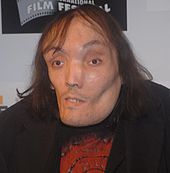- McCune–Albright syndrome
-
McCune-Albright syndrome Classification and external resources 
Café-au-lait skin pigmentation.
A) A typical lesion on the face, chest, and arm of a 5-year-old girl with McCune-Albright syndrome which demonstrates jagged "coast of Maine" borders, and the tendency for the lesions to both respect the midline and follow the developmental lines of Blaschko.
B) Typical lesions that are often found on the nape of the neck and crease of the buttocks are shown (arrows).ICD-10 Q78.1 ICD-9 756.54 OMIM 174800 DiseasesDB 7880 MedlinePlus 001217 eMedicine ped/1386 MeSH D005359 McCune–Albright syndrome, described in 1937 by Donovan James McCune and Fuller Albright,[1][2][3] is a genetic disorder of bones, skin pigmentation and hormonal problems along with premature puberty.
Contents
Symptoms
It is suspected when two of the three following features are present:
- (autonomous) endocrine hyperfunction such as precocious puberty
- Polyostotic fibrous dysplasia
- Unilateral Café-au-lait spots
Presentation
Within the syndrome there are bone fractures and deformity of the legs, arms and skull, different pigment patches on the skin, and early puberty with increased rate of growth.
Polyostotic fibrous dysplasia has different levels of severity. For example one child may be entirely healthy with no outward evidence of bone or endocrine problems, enter puberty at close to the normal age and have no unusual skin pigmentation. The complete opposite of that would be children who are diagnosed in early infancy with the obvious bone disease and obvious increased endocrine secretions from several glands.
Approximately 20-30% of fibrous dysplasias are polyostotic and two thirds of patients are polyostotic before the age of ten.
Polyostotic fibrous dysplasia is usually caused by mosaicism for a mutation in a gene called GNAS1 (Guanine Nucleotide binding protein, Alpha Stimulating activity polypeptide 1).
The syndrome shows a broad spectrum of severity. The disease frequently involves the skull and facial bones, pelvis, spine and shoulder girdle. The sites of involvement are the femur (91%), tibia (81%), pelvis (78%), ribs, skull and facial bones (50%), upper extremities, lumbar spine, clavicle, and cervical spine, in decreasing order of frequency. The craniofacial pattern of the disease occurs in 50% of patients with the polyostotic form of fibrous dysplasia.
Genetics
Genetically, there is a post-zygotic mutation of the gene GNAS1, which is involved in G-protein signalling.[4] This mutation, often a mosaicism, prevents downregulation of cAMP signalling.
Notable cases
The disease made headlines in December, 2005 when a Haitian teen afflicted with the disease, Marlie Casseus, underwent a 17-hour emergency surgical procedure to remove a 7 kg (16 pound) tumour-like growth of bone from her face. A series of operations at Holtz Children's Hospital in Miami, Florida restored the child's face to a more normal proportion.[5]
See also
- Fibrous dysplasia
- List of cutaneous conditions
References
- ^ synd/1844 at Who Named It?
- ^ McCune DJ, Bruch H (1937). "Progress in pediatrics: osteodystrophia fibrosa". Am. J. Dis. Child. 54: 806–848.
- ^ Albright F, Butler AM, Hampton AO, Smith P (1937). "Syndrome characterized by osteitis fibrosa disseminata, areas of pigmentation and endocrine dysfunction, with precocious puberty in females: report of five cases". New Eng. J. Med. 216 (17): 727–746. doi:10.1056/NEJM193704292161701.
- ^ Collins MT, Sarlis NJ, Merino MJ, et al. (September 2003). "Thyroid carcinoma in the McCune-Albright syndrome: contributory role of activating Gs alpha mutations". J. Clin. Endocrinol. Metab. 88 (9): 4413–7. doi:10.1210/jc.2002-021642. PMID 12970318. http://jcem.endojournals.org/cgi/pmidlookup?view=long&pmid=12970318.
- ^ "Marlie Casseus". Archived from the original on 2007-05-29. http://web.archive.org/web/20070529015047/http://www.internationalkidsfund.org/ikf_kids/details.cfm?KD_ID=123. Retrieved 2007-07-14.
External links
- Medterms.com
- GNAS gene
- NORD
- GFMER
- Fibrous Dysplasia Radiology Image Database
Osteochondrodysplasia (Q77–Q78, 756.4–756.5) Osteodysplasia/
osteodystrophyOther/ungroupedFLNB (Boomerang dysplasia) · Opsismodysplasia · Polyostotic fibrous dysplasia (McCune-Albright syndrome)Chondrodysplasia/
chondrodystrophy
(including dwarfism)enchondromatosis (Ollier disease, Maffucci syndrome)Other dwarfismFibrochondrogenesis · Short rib-polydactyly syndrome (Majewski's polydactyly syndrome) · Léri-Weill dyschondrosteosisCategories:- Genodermatoses
Wikimedia Foundation. 2010.

